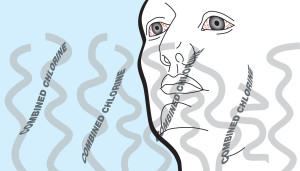Myth 8: A strong chlorine odour around an indoor pool, and bathers complaining of red eyes and itchy skin, indicate too much sanitizer has been applied
Similar to the answer above, combined chlorine is the real culprit here as well. To reduce these chloramines, the water actually needs to have more chlorine added—up to the so-called breakpoint level.

Generally, the formula followed for breakpoint chlorination is to raise the free chlorine level all at once to 10 times the measured combined chlorine level. If breakpoint is not achieved, the problem will become worse. Superchlorinating this way will also oxidize any organic matter, resulting in crystal-clear water. The procedure is best performed in the evening to minimize chlorine destruction by sunlight.
Myth 9: When balancing water, a total hardness reading is more desirable than a calcium hardness reading
Total hardness consists of both calcium (Ca) and magnesium (Mg) salts; however, only the calcium component is relevant in the LSI water balance calculation for pools/spas. This calculation considers the interrelationships of four chemical factors—calcium hardness; pH; total alkalinity, as corrected for the contribution of any cyanuric acid stabilizer in use; and, to a much lesser extent, the TDS level; plus one physical factor, water temperature.

Calcium hardness must be actively managed—along with pH and total alkalinity—to keep water in proper chemical balance. The only way to lower calcium hardness is by partially draining the pool/spa and replenishing with water containing lower levels of calcium hardness. Current industry standards require calcium hardness levels to be maintained in pools at the ideal range of 200 to 400 ppm, and 150 to 250 ppm in spas. Pools regularly sanitized with calcium hypochlorite (Ca[ClO]2) (cal hypo) will see the calcium hardness reading steadily increase. To avoid going out of the recommended range, at some point it will be necessary to switch to another form of chlorine for a period of time.
Myth 10: The effectiveness of a reagent primarily depends on how old it is; or manufacturers recommend replacing reagents annually because they want to make more money, not because it is the prudent thing to do; or keeping your test kit in a refrigerator between use will prolong reagent shelf life.
Misinformation about the useful life of reagents is widespread. I’ve lumped several myths together here that can all be cleared up with the simple understanding that reagents are by nature perishable, just like milk, produce or medicines. This is true whether they are liquids, powders, crystals, tablets or test strips, although shelf life does vary by type. For instance, if kept dry, powders and crystals are very stable; acids are also long lived. Other reagents are more susceptible to degradation, like DPD or silver nitrate (AgNO3) reagents. (Their opaque bottle is your hint the reagent is very light sensitive.)
Proper storage is key
Date of manufacture is not the controlling factor when it comes to shelf life—storage conditions are more important. When not in use, reagents do best in a cool, dark place, away from volatile treatment chemicals, especially chlorine and bromine. Inventory should be dated and rotated according to the first in, first out (FIFO) principle. Ideal storage temperatures are between 2 to 29 C (36 to 85 F). If you must choose between a hot warehouse (or vehicle trunk) and the refrigerator, opt for the latter for longer-term storage. Keeping reagents in the refrigerator will prolong shelf life; however, once removed, they should be used completely rather than subjecting them to constant fluctuations in temperature, which will cause them to degrade faster. Accidentally freezing a reagent may not render it useless; ask the manufacturer.






